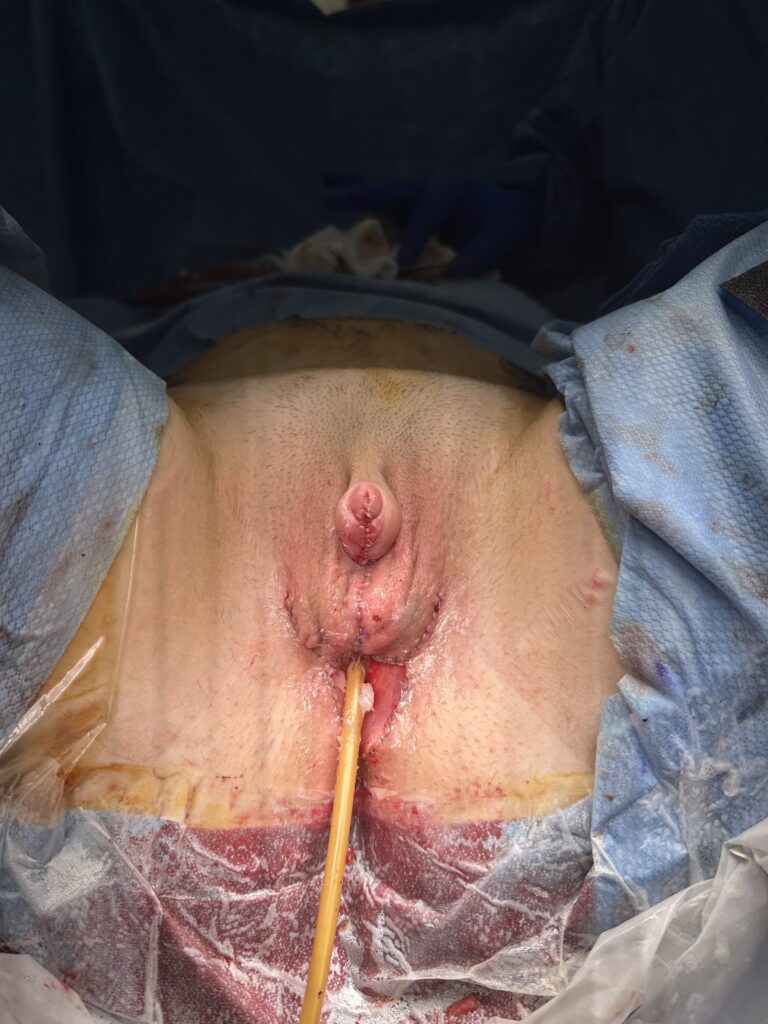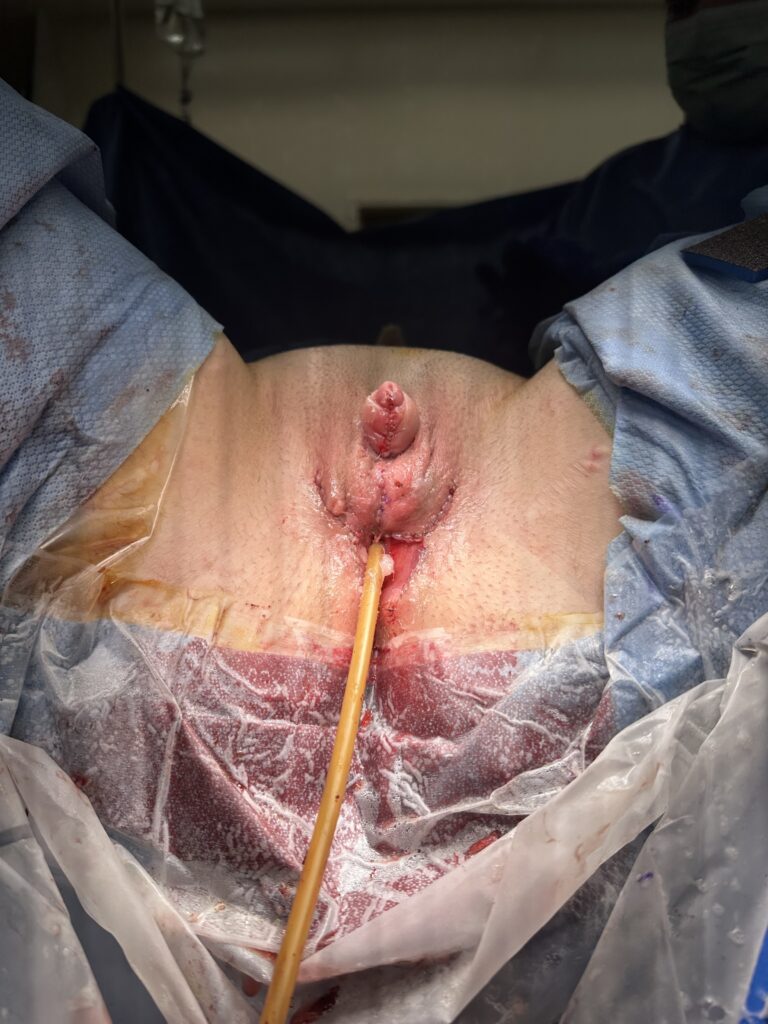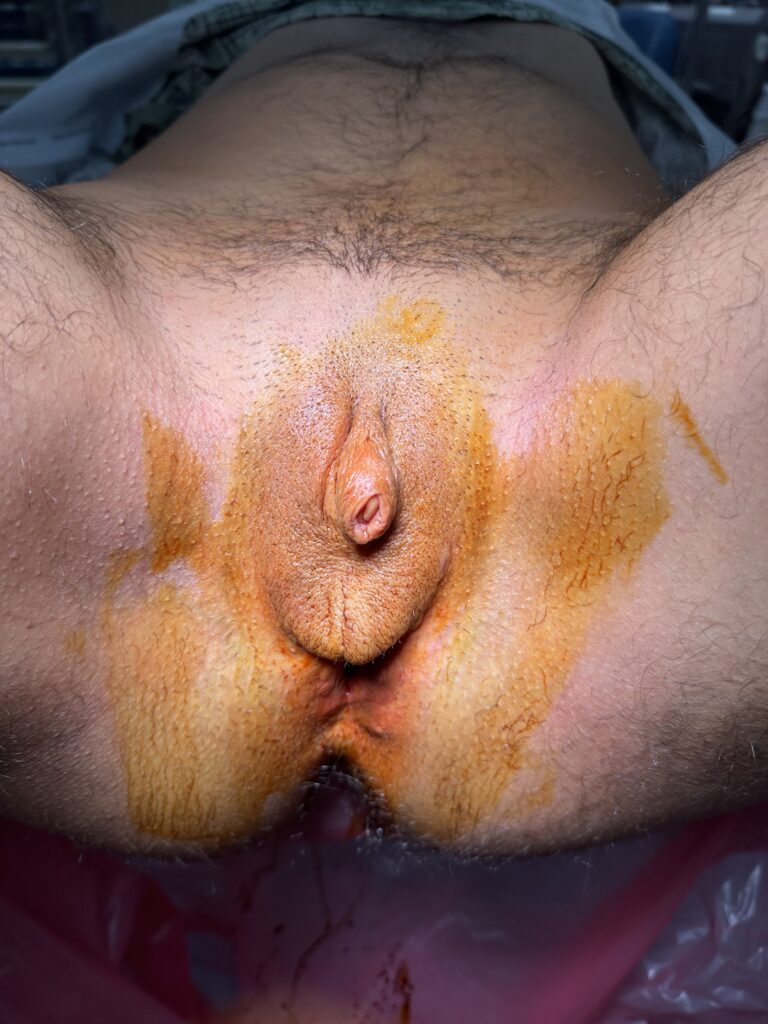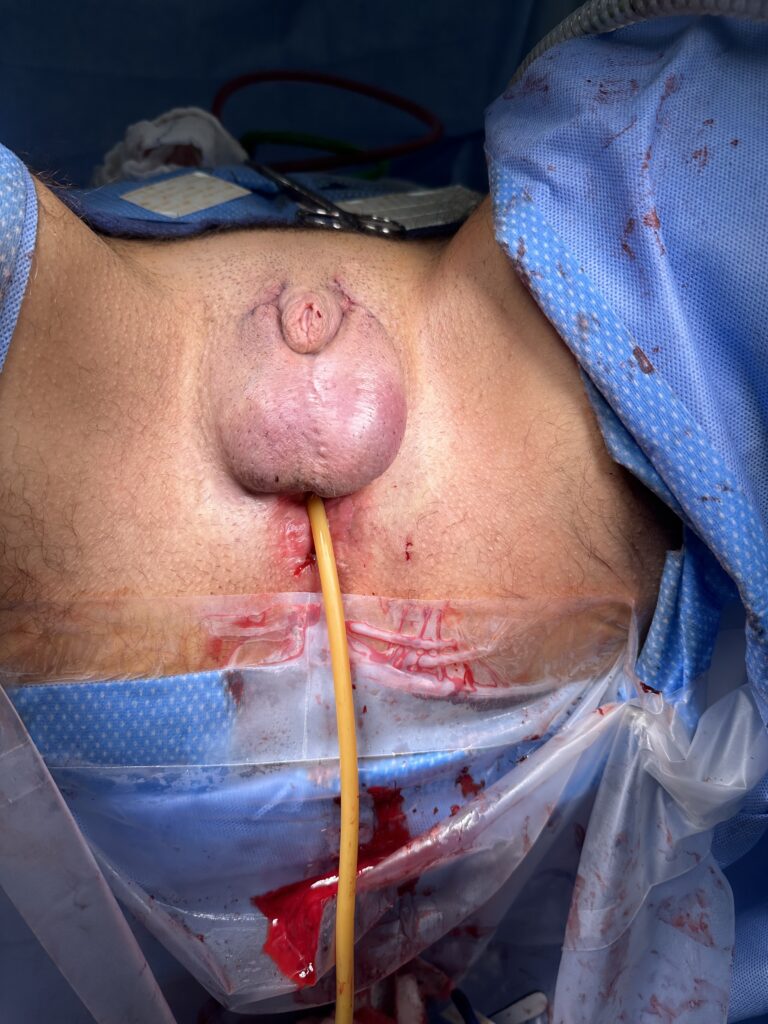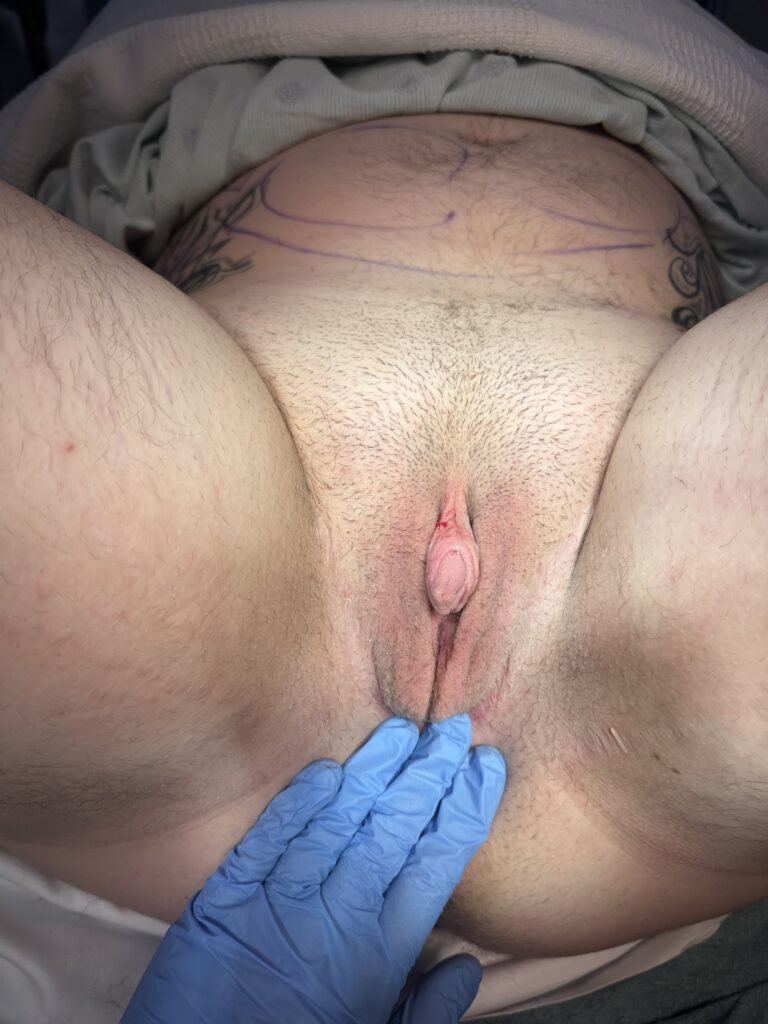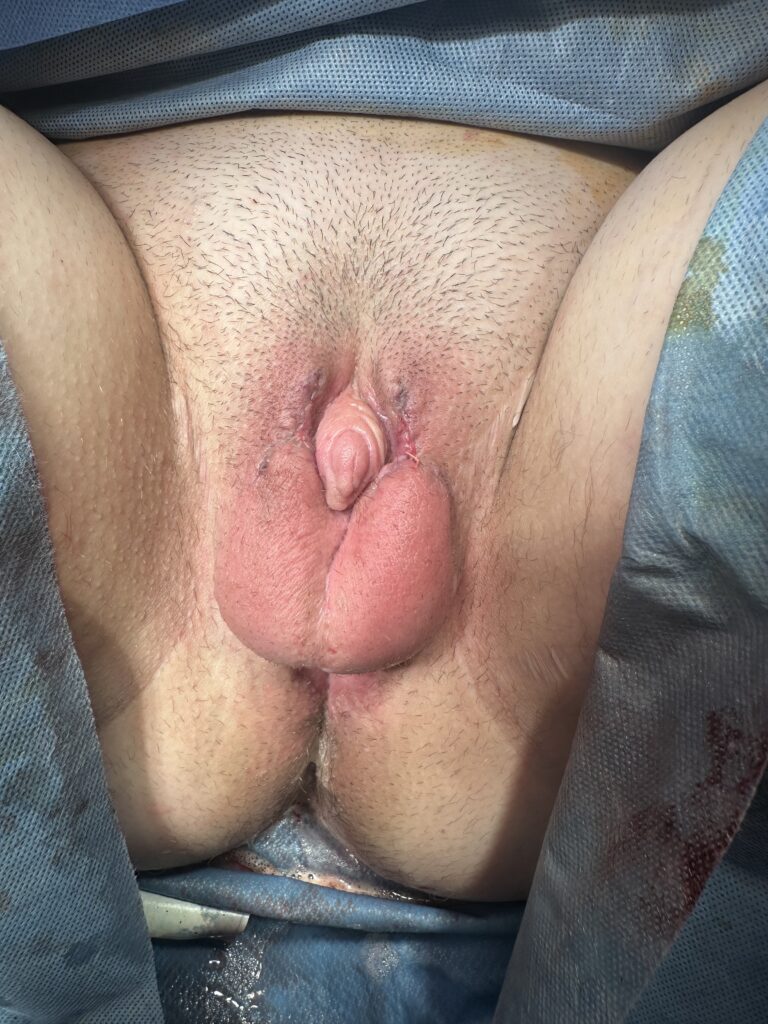
Metoidioplasty

What is metoidioplasty surgery?
In this surgery we aim to bring your penis forward to get more length but also position the penis into a more forward-facing position. In addition, metoidioplasty can be combined with or without urethral lengthening, scrotoplasty, hysterectomy and vaginectomy.
Goals:
1. Give penis more length by releasing ligament attachment
2. Position penis to a more forward position
3. Remove, reposition, reshape local tissue to make penis more visible
Each patient’s surgery and results are different.
Simple Metoidioplasty
This is by far the most common technique for metoidioplasty. In this operation, the inferior ligaments are released allowing the penis to come forward and rotate up. This gives more length, but also makes the penis more visible. The labia minora attachments are released reconfigured or removed to give more framing to the penis. This can be combined with other procedures.
Ideal candidate: Someone at a stable weight with enlarged penis from testosterone.
Limitations: Those with less enlargement of the penis will have less of an improvement. Those with large amounts of groin, mons, or lower abdomen fullness may not notice results. Your surgeon will discuss your specific anatomy with you.
Scrotoplasty w/wo Implants
Often combined with metoidioplasty, this procedure repositions the labia majora to create a scrotum. Depending on the chosen surgical approach, testicular implants can be placed at the same time or as a secondary procedure in the future.
The simplest type is to place implants into the current tissue with minimal amount of tissue rearrangement. The benefit of this technique is that implants are placed, and no second stage is needed. The disadvantage is that the scrotum is separated, and implants can be a bit high riding. Some will have a secondary surgery to unify the scrotum as a second stage.
More commonly the scrotum can be created by making flaps (a surgical term for tissue that is moved to a new location) from the lower portion of the labia majora and bringing them centrally to make a cohesive scrotum. This brings a scrotum that is well-formed beneath the penile shaft. This is allowed to heal, and then the implants are placed at a second surgery after about 3 months. This second surgery can be combined with a V-Y advancement where the upper portion of the labia majora is moved lower to give more projection of the penis and adds more volume to the scrotum.
Ideal candidate: Someone at a stable weight looking for creation of a scrotum.
Limitations: Size and shape of scrotum is dependent on your anatomy and will be different from person to person. Your surgeon will discuss your specific anatomy and goals.
Urethral Lengthening
Done at the same time as metoidioplasty. In this procedure a skin tube is created from skin of urethral plate, perineal tissue, and labia minora to extend the urethra with the possible goal of standing to urinate. A urinary catheter, e.g. Foley, is left in place to allow the new urethra to heal before allowing urine to pass through it.
Ideal candidate: Someone at a stable weight looking for urethral lengthening with good amount of tissue to create the urine tube.
Limitations: This surgery typically needs to be done with a vaginectomy. It is not always possible to get urethra to the tip of the penis and therefore cannot always guarantee that you will be able to stand while urinating. Unfortunately, urethral fistula (an undesirable connection between the urethra and another part of the body) can be a common and difficult problem to fix in this surgery. Your surgeon will talk more of the risks and benefits of this.
A suprapubic catheter will be placed in the lower part of your abdomen directly into your bladder. This will stay in place for 4 weeks while the urethra extension heals. You will have a catheter in your urethral extension for 1 week. Once this catheter is removed, you will continue to drain urine though the suprapubic catheter. At 4 weeks we will clamp the suprapubic catheter and will trial urinating through the urethra extension. If this is successful the suprapubic catheter will be pulled and allowed to heal.
After Care
Metoidioplasty is a surgery that will typically limit physical activity for 2-6 weeks depending on the type of procedure you have . A large part of its success depends on your preparedness. This means being in the best possible physical and mental health before the surgery.
Above all else, it is critical to have reasonable expectations about what is possible for your body and what your surgeon can realistically accomplish. We recommend you:
• Talk with a mental health professional with an understanding of gender care to help navigate this challenging and exciting period of your life.
• Connect with peers who have been through this surgery for support. Please keep in mind that each person’s surgical plan and experience is unique. Information shared on some forums may not be relevant to your surgery. Due to patient privacy laws, we never comment on another patient’s specific issues. We are happy to clarify anything related to your individual care.
This guide will help you meet all the pre-surgery requirements, prepare for surgery, and plan for your recovery. We are here to help make sure your surgery is successful.
Maximizing Healing
We like to think about surgery like running a marathon. You will be stressing your body and will have to do significant healing. In the weeks to months before surgery maximizing your health, both mental and physical, will help you recover more quickly.
• We recommend getting about 0.5 gram of protein per pound (lb) of weight in a day to maximize healing, e.g. 150lb x 0.5=75g of protein per day.
• We also recommend reducing sugar and processed foods.
• We recommend keeping active before having surgery. Keeping up with or adding a workout plan will help your overall health and help you heal more quickly. We understand that we all have different physical capabilities but even adding daily walking, home yoga, or simple home workouts with body weight can help.
Stopping smoking/nicotine
Why is it important?
Nicotine is a powerful drug that constricts your blood vessels and decreases blood flow to the tissues we are operating on. This can cause complications, including poor or delayed wound healing and graft failure. Research shows that risk of surgery failure increases 10 times for people who smoke even one cigarette a day.
How long do I need to be nicotine free?
We require that people not smoke or use any nicotine or tobacco products for at least three months before surgery and at least 3 months after surgery.
What about nicotine patches, gum, e-cigarettes, etc.?
All of these products are a healthier alternative to smoking tobacco, but they all contain nicotine. They can have a similarly negative effect on wound healing. Therefore, we require that you not consume any of these products for three months before surgery.
What about marijuana?
If you use cannabis, please do not smoke or inhale THC or CBC products for at least six weeks before surgery. THC/CBC consumption can increase the amount of anesthesia medication needed during your surgery, and therefore reduction or cessation is encouraged six weeks prior to surgery.
Controlling diabetes
Why is it important?
People with diabetes may have greater risk of poor healing and infections, especially if their diabetes is not well controlled. Your primary care provider or endocrinologist can help you make sure your diabetes is under control before surgery.
Weight Loss
Why is my weight important?
We understand that beauty comes in all shapes and sizes. You don’t have to be skinny to be healthy.
However, being closer to ideal weight will give the best cosmetic outcome in the future. We do not have a cut off BMI (Body Mass Index) but will discuss how your BMI may impact your surgery and safety. Risks of surgery increase as well as difficulty at higher BMIs.
What resources are available to help me lose weight?
Contact your primary care provider to discuss healthy ways to lose weight. Your provider might be able to refer you to a nutritionist, dietitian or gym. Some prescriptions can help with weight loss when used with exercise and a healthy diet. We have operated on patients after successful weight loss surgery.
